Go a little north of Rome on the map and draw a straight line across Italy. Le Marche is just opposite, nestled between the Adriatic Sea and the Apennine Mountains. It shares a border Emilia Romagna to the north, Abruzzo to the south and Umbria, Tuscany and Lazio to the west. The coastline stretches for over 100 miles, with mostly wide and flat beaches, and there’s a relatively short distance between the mountains and the sea. In the band of hills between the two, many of the towns have dramatic views of the coastline.
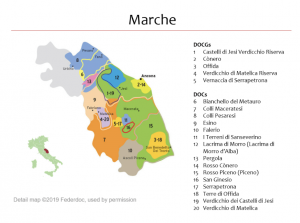
Le Marche has a rich history and a truly diverse territory. From the Frasassi caves to the dramatic cliffs of Monte Conero on the sea to the glacier valleys of the Sibillini mountains, there’s something to interest everyone. With 26 medieval towns to choose from, Urbino and Ascoli Piceno stand out as some of gems to rival those of Tuscany. On the coast, the trabucchi are the traditional fishing shacks anchoring their nets in the sea and making an authentic way to enjoy a pranzo at the beach, as many are also restaurants now.
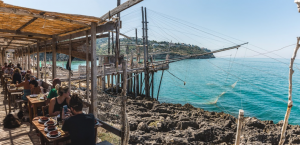
Trabucco on the Adriatic coast Photo by Al Trabucco di Mimi
The first settlement of Le Marche was between the 10th and 9th century BC by the Piceni tribe, thought to have descended from the Sabines who migrated from Lazio and Campania. They were invaded by the Seonese Gauls, a Celtic tribe from northern France around 500 BC. They founded the city of Senigallia, while the Greeks arriving from Syracuse founded Ancona about 120 years later. The city became famous as the production center for purple dye made from sea snail shells and later colored the robes of the emperors. The province known as Picenum became a rich prize for the Romans, who claimed it after the battle of Sentium in 295 BC. One of the most famous roads, the Via Flaminia, was built to connect Rome with the east coast. Fano, a coastal city at the crossroads, became one of the most important of the region as the Via Flaminia met the coast road to Rimini here – allowing Roman troops to access the northern part of the empire. Parts of that road, bridges and all, are still in use 2000 years later.
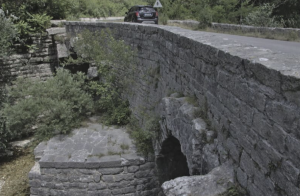
Ponte Mallio – Roman bridge in Acqualagna Photo by Eccolemarche
After the fall of the Roman empire, Le Marche was occupied by a number of northern Goth tribes, then the Byzantines. The Lombards came in 568 and 200 years later, Charlemagne was crowned King of the Lombards in 774. Uniting most of western and central Europe, he was crowned “Emperor of the Romans” by Pope Leo III in 800 and the Marche passed into the Holy Roman Empire. Federico II di Svevia was born in Jesi in 1194 and could be considered the first modern ruler who tried to unite Italy. His vast kingdom stretched from Sicily to Germany to France and brought great prosperity. From the 11th to the 17th century, it was the nobility who shaped and led the region, many becoming patrons of the Renaissance. Their handiwork is seen today in the palaces, castles, artwork, churches and piazzas found in Urbino, Ancona, Ascoli Piceno, and Macerata. The region was firmly under the control of the Papal States by 1600 and remained so until the unification of Italy in 1860, except for a 26 year period as the Roman Republic under Napoleon from 1787-1813. As industrialization came slowly to Le Marche, many of the villages and the countryside are preserved in their historic splendor. The development of the coastal resorts started in the early 20th century and today they represent an important tourism drawing card.
Monte Conero, about halfway down the coast, creates a dividing line between two types of climate. A mostly Mediterranean climate south of here – mild winters with breezy and warm summers, with lower rainfall. In the northern section, there’s exposure to the cool winds coming from the northeast and giving the area a more continental climate, with fog and cold temperatures. Closer to the mountains, the winters turn colder and snowy. Much of the annual rainfall occurs between spring and autumn.
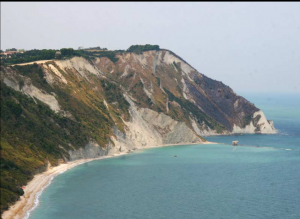
Monte Conero Photo by Italia Azienda Nazionale Turismo
The many rivers and streams descend from the Apennines and flow towards the coast in perpendicular fashion. They create a series of funnels for ocean air currents to move inland towards the mountains which are only 20 miles away
The soils correspond to three different sets of hills. The first is a set of low hills by the coast running south from Pesaro. Here we find a clay and sand/gravel mixture from marine sediments. The hills around Pesaro and Urbino, another set near Castelli di Jesi and those around Ancona, Macerata, Offida and Ascoli Piceno contain calcareous clay – clay with a high limestone content. Further inland is the third set of hills which run parallel to the Apennines and are mid-to-high in elevation, around Matelica and Serrapetrona. This area has sandstone, marl and clay soils, ideal for producing quality wines. Rivers and streams descend from the Apennines and flow towards the coast in perpendicular fashion.
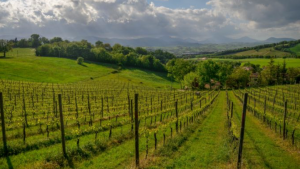
Vineyards in hills of Matelica Photo by Vinix
While superbly suited for white grape varieties, the production of Le Marche is close to 50% red/white. With 5DOCG and 19 DOC denominations, the region is no stranger to quality. Four red grape varieties form the basis of most of the red wines – two of the most famous are right at home here, Sangiovese and Montepulciano. Two native red grapes of lesser fame are grown here, Lacrima di Morro d’Alba and Vernaccia Nera. Sangiovese tends to be grown north of Conero and Montepulciano in the southern part, as Conero represents the northern limit of where the Montepulciano grape will properly ripen.
Lacrima is an ancient aromatic red grape which grows around the town of Morro d’Alba. It has intense floral aromas of rose and violet and spicy notes, with rich berry flavors on the palate. After the siege of Ancona in 1167, Frederick I became quite a fan, but like many native grapes, it was almost extinct by the 20th century. Cultivated by a handful of producers, it is making a comeback. Found in still and sparkling styles, it has a rich dark color with substantial tannins and pairs beautifully with lamb and rabbit dishes, salamis and hams, pasta with meat sauces and medium-aged cheeses. Vernaccia Nera is thought to be related to Spain’s Garnacha. Found inland, in the foothills of the Apennines, its home is around the town of Serrapetrona and only about 60 acres are planted. Vernaccia di Serrapetrona is a unique red sparkling wine, made in the tank or Charmat method. It can be either sweet or dry, and undergoes three fermentations – the first at harvest in October, the second in January when air dried grapes are added to the must and the third in the tank before being bottles. This is a wine of raspberry color, bright acidity, aromas of strawberry and cranberries, hints of spices with firm tannins. The sweet version is ideal with dessert and the dry version with the local Ciauscuolo, spreadable salami and pecorino cheese.
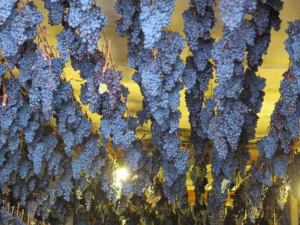

Vernaccia Nera grapes drying | Photo by WonderfulMarche.com Ciausculo salami | Photo by WonderfulMarche.com
The Conero DOCG growing area is positioned just south of Monte Conero, which reaches almost 600 meters above sea level. The unique clay and chalk soils here, along with the microclimate, produce exceptional wines made mostly with Montepulciano d’Abruzzo. Powerful wines with high acidity, they have great potential for aging. Characterized by intense floral notes of roses and cherries, the wine has fresh fruit aromas when young which age into dried roses, cherry jam, black fruits and balsamic notes. For lovers of Barolo and Brunello, this wine is one to try. Rosso Conero DOC is also a minimum of 85% Montepulciano, but doesn’t have the ageing requirements of the DOCG. It is a fresher and more easy to drink version, with the same flavor profile. Try it with lasagna (called Vincigrassi in Le Marche!) or duck ragu.
Rosso Piceno DOC can be produced in the area of the 13 most southern towns of Le Marche, centered around Ascoli Piceno. It is a combination of Montepulciano and Sangiovese, in varying proportions. Grown in mostly clay soils, at medium elevations on south and south-east facing slopes, these wines are fresh and easy to drink. With aromas of wild cherry and plum, and a hint of balsamic, it pairs well with a platter of pecorino and salami, as well as chicken alla cacciatora (in the hunter’s style).
The jewel in the viticultural crown of Le Marche is Verdicchio. The name means “little green one”, referring to the color of the wine, a pale yellow with greenish reflections. Although white wines have been in the area since the time of the Romans, around the end of the 15th century, families from Veneto and Lombardia migrated south to occupy and work lands that had been abandoned during the years of the plague. They brought a grape with them, very likely Trebbiano di Soave, genetically very similar to present day Verdicchio. Over centuries, it has adapted to the soils and microclimates, in particular in the area of Jesi, closer to the Adriatic, and Matelica, in the foothills of the Apennines. As wine writer Michaela White points out, “Jesi is the Verdicchio that sees the sea, Matelica is the Verdicchio of the mountains.” Both types are also used for sparkling and sweet wines as the high acidity of the grape lends itself to each style.
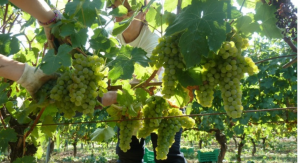
Verdicchio grapes at harvest Photo by Wine Dharma
Verdicchio dei Castelli di Jesi DOC is the larger production area and its wines are cultivated in the hilly area around the town of Jesi, west of Ancona. A region of fortified medieval villages – much like Tuscany – they form the “castelli” in the name of the wine. The soils of calcareous clay as well as the gentle sea breezes and the temperate dry climate provide ideal growing conditions for the vine.
There are Classico, Superiore and Riserva designations. Classico refers to the area; in this case, the oldest and original zone of production to the south of the Misa river. Superiore are wines from the Classico area that are a step up in quality, frequently coming from either single vineyards or special parcels of land. Usually they tend to be more structured and full-bodied. The Riserva wines have been designated DOCG with requirements for 18 months of ageing, with a minimum of 6 months in the bottle. They are richer and fuller and typically deeper in color, fully capable of ageing. The wine profile is one of high acidity and good structure, with flavors of citrus and yellow fruits. There is a distinctive note of bitter almond on the finish, which is the hallmark of this wine. With ageing, flavors become more complex – candied fruit, bread and marzipan.
Further inland, close to the border of Umbria, Verdicchio di Matelica DOC can be found in a valley running north to south. The hills block the maritime temperature-moderating influences and the climate is more continental at the higher altitudes. Soils are comprised of layers of clay and limestone, marl and sandstone. The production area is small, just 1/10 the size of that of Jesi, with those more complex soils. The cooler climate produces wines that are higher in acidity, less fruity and floral, with more notes of citrus and a decidedly mineral finish. They generally require a few years in the bottle, as they tend to be more austere and restrained when young. As with the Jesi wines, the Riserva designation requires 18 months of ageing.
In the hills west of Macerata, the Colli Maceratesi DOC, Maceratino (or Ribona) is grown, a rare white grape native to the area. A refreshing wine, it has aromas of white flowers, pear, apple and citrus, with a finish of salinity and minerals. In the south, in the province of Ascoli Piceno, the native grape of Passerina is found around the town of Offida. These wines are floral in aroma, with notes of ripe citrus and tropical fruit and pronounced minerality.
Up and coming from the far southwest corner of Le Marche is Pecorino, a native white grape almost forgotten during the 20th century until the 1980s. Guido Grifoni discovered an old vineyard of ungrafted vines and cultivated the cuttings at his own property. He began producing wine in 1990. Now the vine is widely planted in this part of the region and south into Abruzzo. It does well at high altitudes, producing grapes with both high acidity and high sugar levels. This is a wine of high acidity, minerality, has aromas of jasmine and acacia, with flavors of apple, tropical fruit and citrus and notes of anise. The name comes from the word for sheep, pecora, as its home was the area around Monti Sibillini, known for sheep farming.
The wines of Le Marche are perfectly married to its regional dishes. On the coast, one finds a different recipe for Brodetto in every town. Here’s one for Brodetto all’Anconetana:
http://www.italia.it/en/travel-ideas/gastronomy/cooking-with-italiait/the-marches/brodetto-allanconetana-soup-of-ancona.html
Stockfish or Stocafisso all’Anconetana is another famous dish of Ancona, typically prepared in the winter months and made from air-dried cod – a legacy of the Venetian Republic. Any of Le Marche white wines can accompany the seafood dishes, but Verdicchio is always perfect.
https://www.eccolemarche.eu/en/blog/2020/12/03/stoccafisso-allanconitana/
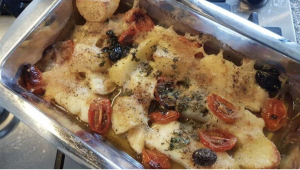
Stocafisso all’Anconetana Photo by Eccolelemarche.com
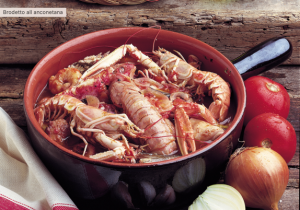
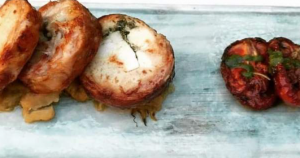
Brodetto all’Anconetana | Photo by La Cucina Italiana Coneglio in Porchetta | Photo by Osteria di Via Leopardi
Turning from the sea to the countryside, rabbit dishes are a great favorite. Coneglio in Porchetta is a traditional Marchese dish, a roast made with deboned rabbit and various ingredients. (Have the butcher prepare the rabbit to try this.) Pair with a aged Verdicchio or Rosso Piceno.
https://www.consorziovinipiceni.com/recipe/coniglio-in-porchetta/?lang=en
White truffles are found near Acqualagna. Shave some over fresh tagliatelle. Crescia, a cross between the piadina bread of the Romagna area, but made with eggs like a crepe, is a favorite street food of Le Marche. It can be found with all types of fillings – cheese, ham, and vegetables.
Just don’t call it lasagna! Here the richer version is known as Vincigrassi. To set it off perfectly, try it with the wines of Conero – a big Montepulciano which is a match for the meat, cheese and tomatoes of this dish. Also found in the Conero are moscioli, the wild mussels native to this area. On the beach, have a plate of spaghetti made with moscioli and tomato sauce – just don’t call them mussels!
If you travel down to Ascoli Piceno, make sure to try the Olive all’Ascolana – olives stuffed with meat, breaded and deep-fried. A glass of Pecorino or Passerina will make a nice aperitivo.
Visit Le Marche and try the wines where the grapes are grown. From medieval towns to the beaches to hiking on wild mountain trails and fabulous food, it has everything!
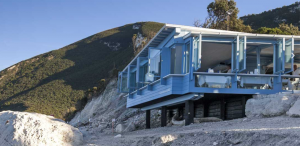
Clandestino Susci Bar Photo by Moreno Cedroni, Chef
